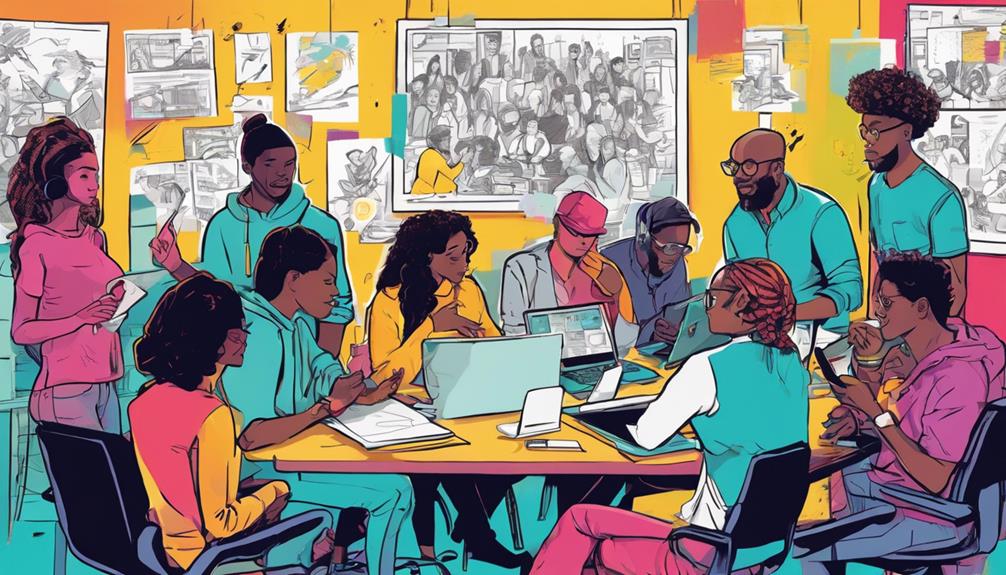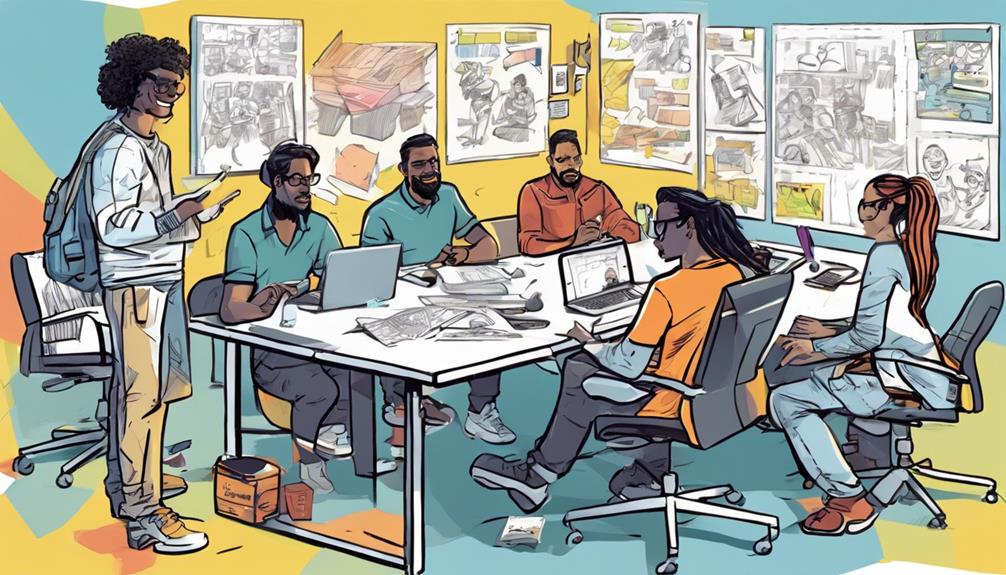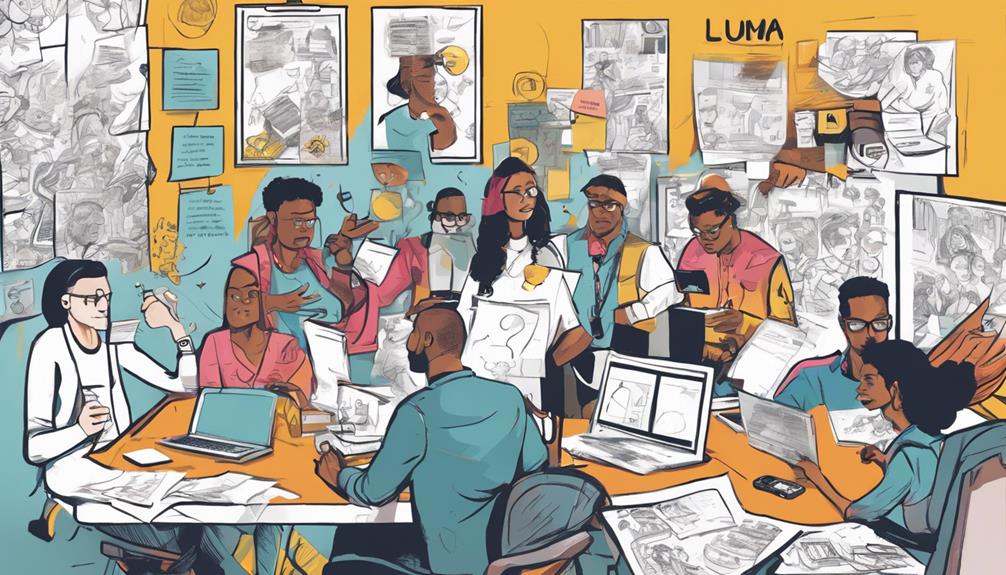Embark on a transformative journey from initial concepts to real-world solutions with the Design Thinking Approach. Innovation thrives through empathetic ideation and iterative prototyping that aims to make a tangible impact on users and businesses. Unleash creativity, foster collaboration, and drive innovation to address complex challenges effectively. Prioritize user needs and experiences for impactful problem-solving. As you explore this methodology, discover how a human-centered approach can enhance customer satisfaction, market differentiation, and foster a culture of experimentation. Be prepared to challenge conventional practices and uncover new possibilities for tailored solutions that cater to evolving market demands and customer needs.
Key Takeaways
- Human-centered approach prioritizes user needs.
- Iterative ideation and prototyping based on user feedback.
- Fosters creativity, collaboration, and innovation.
- Drives impactful solutions for complex challenges.
- Enhances customer satisfaction and market differentiation.
Understanding Design Thinking Process
To understand the design thinking process, begin by recognizing its core stages and principles. Design thinking is a human-centered approach that emphasizes the importance of understanding user needs and experiences. By prioritizing empathy and user-centricity, this approach guarantees that solutions are tailored to address real-world problems effectively.
The iterative nature of design thinking encourages continuous cycles of ideation and prototyping to refine and improve solutions based on user feedback. Central to the design thinking approach is the belief that fostering creativity, collaboration, and innovation is key to tackling complex challenges.
By engaging in activities such as brainstorming, co-creation, and rapid prototyping, individuals and teams can develop innovative solutions that truly resonate with users. This process allows for the exploration of a wide range of ideas before narrowing down to the most promising ones through testing and iteration.
Ultimately, design thinking empowers organizations to develop impactful solutions that drive positive outcomes for both users and the business.
Applying Design Thinking Skills

Design thinking skills, driven by empathy, collaboration, and iteration, are instrumental in fostering innovation and problem-solving. By applying design thinking in your approach to problem-solving, you can enhance customer satisfaction and differentiate yourself in the market.
This methodology not only leads to improved products and services but also cultivates a culture of experimentation, creativity, and continuous learning within your organization. Embracing design thinking in business can revolutionize customer experiences and set your offerings apart from the competition.
Additionally, integrating private 5G networks and edge computing technologies complements the design thinking process by enabling faster data processing, enhanced security, and the development of low-latency applications. By leveraging these tools alongside your design thinking skills, you can drive impactful solutions that cater to evolving market demands and customer needs.
Design Thinking in Business Innovation

You'll discover how empathy, collaboration, and iteration drive impactful solutions in business innovation through a human-centered approach.
By focusing on user needs and experiences, design thinking enhances customer satisfaction and loyalty.
Embracing a cross-functional lens fosters teamwork and continuous learning for ongoing improvements.
Innovation Through Empathy
Understanding your customers' needs through empathy is key to driving successful business innovation using design thinking. By putting yourself in the shoes of your customers, you can gain valuable insights into their preferences, pain points, and behaviors. This empathetic approach allows businesses to create products and services that truly resonate with their target audience, leading to higher satisfaction and loyalty.
| Benefits of Empathy in Design Thinking |
|---|
| 1. Customer-Centric Solutions |
| 2. Enhanced User Experience |
| 3. Increased Customer Satisfaction |
| 4. Improved Brand Loyalty |
Design thinking encourages businesses to prioritize empathy throughout the innovation process, ensuring that solutions are not only functional but also emotionally resonant with users. By fostering a deep understanding of customer needs and motivations, companies can develop products and services that make a genuine impact on the market. Empathy-driven innovation is a powerful tool for creating meaningful connections with customers and driving long-term success in today's competitive business landscape.
Collaborative Customer Focus
To drive successful business innovation, collaborative customer focus through design thinking involves leveraging empathy and cross-functional collaboration to create customer-centric solutions. By prioritizing the user experience, organizations can enhance customer satisfaction and loyalty.
Design thinking encourages teams to work together across departments, breaking silos and fostering creativity to address customer needs effectively. This approach emphasizes the importance of understanding the customer's perspective, preferences, and pain points through empathy-driven insights.
Through iterative processes, design thinking allows for continuous learning and improvement based on customer feedback and insights. By involving customers in the design process, organizations can develop solutions that resonate with their target audience, leading to increased engagement and brand loyalty.
Collaborative customer focus in business innovation not only drives product and service enhancements but also cultivates a customer-centric culture within organizations, ultimately resulting in sustainable growth and competitive advantage.
Iterative Cross-Functional Approach
In implementing an iterative cross-functional approach within business innovation, design thinking serves as a catalyst for collaborative problem-solving and creativity. Design thinking approaches problem-solving by emphasizing a human-centered perspective, driving innovation through a deep understanding of user needs.
By fostering collaboration and iteration, design thinking encourages cross-functional teams to work together, leveraging diverse expertise to generate innovative solutions. This user-centric focus not only leads to higher customer satisfaction and loyalty but also enhances the overall customer experience.
The iterative nature of design thinking allows for continuous learning and improvement, enabling organizations to adapt quickly to changing market demands. Additionally, by challenging the status quo, design thinking drives organizations to innovate and differentiate their products and services, staying ahead in competitive markets.
Embracing design thinking principles in an iterative cross-functional approach can have a significant impact on business innovation, paving the way for sustainable growth and success.
Customer-Centric Impact of Design Thinking

You'll explore how design thinking enhances user experience and cultivates an innovative organizational culture.
By prioritizing customer needs and pain points, design thinking fosters loyalty and differentiation in the market.
Embracing this approach challenges conventional practices and opens doors to new possibilities for impactful customer solutions.
User Experience Enhancement
Enhancing user experiences through a customer-centric approach is a core outcome of implementing design thinking methodologies. By embracing design thinking principles, organizations explore deeply into understanding user needs, behaviors, and pain points to create solutions that resonate with their customers.
This approach drives higher levels of customer satisfaction and loyalty as products and services are tailored to address specific user requirements effectively.
Through the lens of design thinking, companies undergo a transformative shift towards a more customer-centric mindset. This change enables them to not only meet but exceed customer expectations by constantly iterating and improving based on user feedback.
Design thinking empowers teams to think outside the box, challenge traditional norms, and explore innovative ways to deliver exceptional user experiences.
Ultimately, the application of design thinking fosters a culture of innovation and collaboration within organizations. This culture sets the stage for differentiation in the competitive market landscape and drives impactful user experiences that keep customers engaged and delighted.
Innovation Culture Development
Developing a culture of innovation through design thinking involves prioritizing empathy, collaboration, and iteration in problem-solving to enhance customer-centricity. By embracing design thinking principles, organizations can better understand the needs of people and drive impactful solutions that resonate with customers.
To foster an innovation culture that revolves around customer-centricity, consider the following:
- Empathy: Placing yourself in the shoes of customers to deeply understand their perspectives and experiences.
- Collaboration: Encouraging cross-functional teams to work together, leveraging diverse skills and knowledge to solve complex problems.
- Iteration: Embracing a process of continuous improvement and refinement based on feedback and insights gathered from customers.
- Experimentation: Creating a culture that values testing new ideas, taking risks, and learning from failures to drive innovation and meet the evolving needs of customers.
Fostering Innovation Culture With Design Thinking

Design thinking serves as a catalyst for fostering a culture of innovation within organizations, encouraging collaboration and experimentation. By focusing on understanding user needs, iterating on solutions, and embracing creativity, design thinking empowers teams to tackle challenges in a human-centered way. This approach not only drives product and service differentiation but also enhances customer experiences by addressing their specific needs effectively. Through design thinking, companies can stay agile in the market, responding quickly to changing demands and trends. By unlocking the creative potential of teams, design thinking leads to innovative solutions that have a real impact on the organization and its customers. Embracing this mindset equips organizations to navigate complexities, drive meaningful innovation, and maintain a competitive edge in today's dynamic business landscape.
| Design Thinking Benefits | Description | Example |
|---|---|---|
| Collaboration | Encourages teamwork and cross-functional cooperation | Design thinking workshops involving employees from different departments |
| Experimentation | Promotes a culture of trying new ideas and learning from failure | Rapid prototyping sessions to test concepts quickly |
| Creativity | Sparks innovative thinking and out-of-the-box solutions | Brainstorming sessions to generate unique ideas |
Human-Centered Design Principles

To understand the core principles of Human-Centered Design, consider its focus on prioritizing people and their context in the design process. This approach revolves around understanding the needs, behaviors, and preferences of individuals to create solutions that truly resonate with them.
Here are some key points to highlight the essence of Human-Centered Design:
- Root Problem Solving: Human-Centered Design delves deeply into uncovering the underlying issues to develop effective and user-friendly solutions.
- Systems Thinking: Viewing everything as interconnected systems allows for a holistic approach that emphasizes inclusivity and diversity in design.
- Prototyping and Iteration: Designers implement small interventions through iterative prototyping to refine solutions based on user feedback.
- Impactful Products: By following the principles of Human-Centered Design, designers can create products that not only meet user needs but also address broader societal challenges effectively.
Design Thinking Vs. Other Approaches

How does design thinking differentiate itself from traditional problem-solving approaches?
Design thinking stands out by prioritizing user needs over aesthetics, focusing on function, and user well-being in a broader socio-technical context.
Unlike some approaches, design thinking emphasizes user-centered solutions and holistic problem-solving through collaboration with diverse professionals. It values inclusivity, empathy, and user involvement, aiming for sustainable and user-centric solutions for various product types and societal challenges.
Design thinking tools address users' needs by emphasizing design by the people and for the people. This approach sets itself apart with an iterative process, prototyping, and implementing small interventions to create user-friendly products and tackle complex challenges effectively.
Learning Importance of Human-Centered Design

Understanding the significance of Human-Centered Design involves prioritizing user needs and context to create impactful and user-friendly solutions. Design thinking offers a unique approach that places people at the center of problem-solving processes.
Here are four key points highlighting the importance of Human-Centered Design:
- Root Problem Solving: HCD emphasizes understanding the core issues by focusing on people and their environments.
- Inclusivity and Diversity: HCD principles prioritize involving users from diverse backgrounds to create products that cater to a wider audience.
- Interdisciplinary Collaboration: Designers implementing HCD work across disciplines to develop holistic solutions that consider various interconnected systems.
- Iterative Prototyping: Through iterative prototyping and small interventions, HCD allows for tailored solutions that effectively address complex challenges.
Resources for Human-Centered Design

Exploring different resources can deepen your understanding of Human-Centered Design principles and their practical applications. To enhance your knowledge, consider taking courses or reading books and articles by experts like Don Norman and the Interaction Design Foundation. These resources provide in-depth insights into the thinking behind Human-Centered Design and its real-world applications.
Additionally, access open-source articles and images to investigate further into the principles and applications of this design approach.
Staying updated on the latest UX literature and design principles is essential for a thorough understanding of Human-Centered Design. By participating in learning opportunities focused on this design thinking, you can improve your skills and create user-friendly products that address societal challenges effectively.
Remember to always keep the focus on people when applying Human-Centered Design to solve global issues. Prioritizing inclusivity, empathy, and user involvement in the design process guarantees that your solutions truly meet the needs of the users you're designing for.
Frequently Asked Questions
What Is the Approach of Design Thinking?
Design thinking is an iterative problem-solving approach that prioritizes empathy and user involvement. It involves understanding, ideating, prototyping, and testing solutions to tackle complex challenges. This method fosters creativity, innovation, and collaboration for impactful outcomes.
What Is the IDEO Design Thinking Model?
The IDEO design thinking model is a human-centered approach emphasizing empathy, collaboration, and iteration. It focuses on understanding user needs and creating innovative solutions. Widely used in various industries, it drives customer-centricity and fosters creativity.
What Is the Idea Behind Design Thinking?
Like a compass guiding a lost traveler, the idea behind design thinking navigates problem-solving by focusing on empathy, collaboration, and iteration. It transforms user needs into innovative solutions, driving creativity and impactful outcomes.
What Is the Stanford Design Thinking Process?
The Stanford Design Thinking Process involves five stages: Empathize, Define, Ideate, Prototype, and Test. You empathize with users, define the problem, generate ideas, create prototypes, and test solutions to create impactful innovations.
Conclusion
So, you've learned about the power of the design thinking approach – from generating ideas to creating impactful solutions.
By embracing human-centered design principles and fostering an innovation culture, you can revolutionize your business and make a customer-centric impact.
Dive deeper into resources for human-centered design to continue honing your skills and driving meaningful change.
Remember, the key to success lies in understanding and applying the principles of design thinking in your everyday work.









